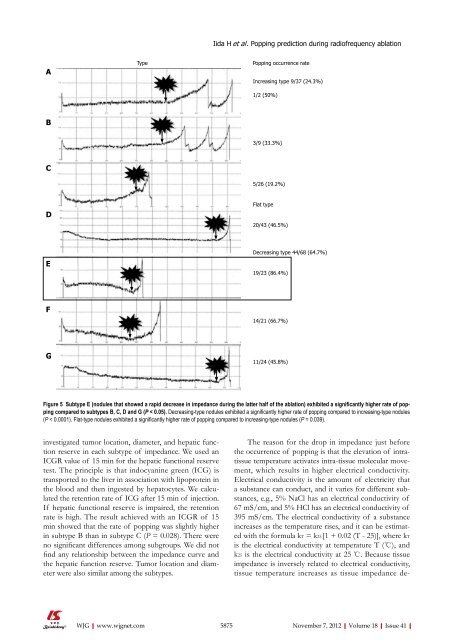Steroid-sparing strategies in the management of ulcerative colitis
Steroid-sparing strategies in the management of ulcerative colitis
Steroid-sparing strategies in the management of ulcerative colitis
You also want an ePaper? Increase the reach of your titles
YUMPU automatically turns print PDFs into web optimized ePapers that Google loves.
A<br />
B<br />
C<br />
D<br />
E<br />
F<br />
G<br />
<strong>in</strong>vestigated tumor location, diameter, and hepatic function<br />
reserve <strong>in</strong> each subtype <strong>of</strong> impedance. We used an<br />
ICGR value <strong>of</strong> 15 m<strong>in</strong> for <strong>the</strong> hepatic functional reserve<br />
test. The pr<strong>in</strong>ciple is that <strong>in</strong>docyan<strong>in</strong>e green (ICG) is<br />
transported to <strong>the</strong> liver <strong>in</strong> association with lipoprote<strong>in</strong> <strong>in</strong><br />
<strong>the</strong> blood and <strong>the</strong>n <strong>in</strong>gested by hepatocytes. We calculated<br />
<strong>the</strong> retention rate <strong>of</strong> ICG after 15 m<strong>in</strong> <strong>of</strong> <strong>in</strong>jection.<br />
If hepatic functional reserve is impaired, <strong>the</strong> retention<br />
rate is high. The result achieved with an ICGR <strong>of</strong> 15<br />
m<strong>in</strong> showed that <strong>the</strong> rate <strong>of</strong> popp<strong>in</strong>g was slightly higher<br />
<strong>in</strong> subtype B than <strong>in</strong> subtype C (P = 0.028). There were<br />
no significant differences among subgroups. We did not<br />
f<strong>in</strong>d any relationship between <strong>the</strong> impedance curve and<br />
<strong>the</strong> hepatic function reserve. Tumor location and diameter<br />
were also similar among <strong>the</strong> subtypes.<br />
WJG|www.wjgnet.com<br />
Iida H et al . Popp<strong>in</strong>g prediction dur<strong>in</strong>g radi<strong>of</strong>requency ablation<br />
Type Popp<strong>in</strong>g occurrence rate<br />
Increas<strong>in</strong>g type 9/37 (24.3%)<br />
1/2 (50%)<br />
3/9 (33.3%)<br />
5/26 (19.2%)<br />
Flat type<br />
20/43 (46.5%)<br />
Decreas<strong>in</strong>g type 44/68 (64.7%)<br />
19/23 (86.4%)<br />
14/21 (66.7%)<br />
11/24 (45.8%)<br />
Figure 5 Subtype E (nodules that showed a rapid decrease <strong>in</strong> impedance dur<strong>in</strong>g <strong>the</strong> latter half <strong>of</strong> <strong>the</strong> ablation) exhibited a significantly higher rate <strong>of</strong> popp<strong>in</strong>g<br />
compared to subtypes B, C, D and G (P < 0.05). Decreas<strong>in</strong>g-type nodules exhibited a significantly higher rate <strong>of</strong> popp<strong>in</strong>g compared to <strong>in</strong>creas<strong>in</strong>g-type nodules<br />
(P < 0.0001). Flat-type nodules exhibited a significantly higher rate <strong>of</strong> popp<strong>in</strong>g compared to <strong>in</strong>creas<strong>in</strong>g-type nodules (P = 0.039).<br />
The reason for <strong>the</strong> drop <strong>in</strong> impedance just before<br />
<strong>the</strong> occurrence <strong>of</strong> popp<strong>in</strong>g is that <strong>the</strong> elevation <strong>of</strong> <strong>in</strong>tratissue<br />
temperature activates <strong>in</strong>tra-tissue molecular movement,<br />
which results <strong>in</strong> higher electrical conductivity.<br />
Electrical conductivity is <strong>the</strong> amount <strong>of</strong> electricity that<br />
a substance can conduct, and it varies for different substances,<br />
e.g., 5% NaCl has an electrical conductivity <strong>of</strong><br />
67 mS/cm, and 5% HCl has an electrical conductivity <strong>of</strong><br />
395 mS/cm. The electrical conductivity <strong>of</strong> a substance<br />
<strong>in</strong>creases as <strong>the</strong> temperature rises, and it can be estimated<br />
with <strong>the</strong> formula kT = k25 [1 + 0.02 (T - 25)], where kT<br />
is <strong>the</strong> electrical conductivity at temperature T (℃), and<br />
k25 is <strong>the</strong> electrical conductivity at 25 ℃. Because tissue<br />
impedance is <strong>in</strong>versely related to electrical conductivity,<br />
tissue temperature <strong>in</strong>creases as tissue impedance de-<br />
5875 November 7, 2012|Volume 18|Issue 41|

















